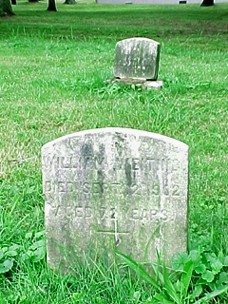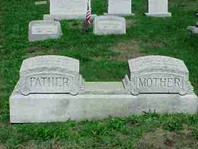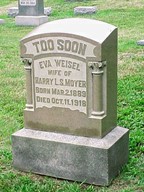| TOMBSTONES At Trinity Lutheran Church Cemetery |
| REMAINS HOME PAGE | MONUMENTS | MAUSOLEUMS | RAILROAD ARTIFACTS |
| TOMBSTONES | MEDALLIONS | STOUT CEMETERY | INDENTURE PAPERS |
| TOMBSTONES At Trinity Lutheran Church Cemetery |
Trinity Lutheran Church Cemetery located on both sides of picturesque "cemetery hill" on Market Street, between 9th Street and the Ridge Road (Rt 563) in Perkasie. Most of the tombstones in this cemetery show dates from the late 1800's and the 1900's.
Early tombstones were often made out of field stones, but the tombstones in the Trinity Lutheran Church Cemetery are made out of marble and granite. Reading the information on the tombstones can tell us a lot about the people who lived in Perkasie in the past.
CEMETERY ORGANIZATION
Tombstones are carefully organized in rows in this cemetery to assist with plot information and organization of the cemetery. Many plots are organized with families together. Cemeteries usually have plot maps to show how the cemetery is organized.
 |
|
| Except for a few early tombstones, which appear somewhat scattered, the stones at Trinity Cemetery are organized in rows. | Without seeing the names on these tombstones one might guess from their style that these tombstones are for members of the same family. |
TOMBSTONE MATERIALS
In many cases the older tombstones are harder to read because they have been worn by the weather or damaged through the years.
| |
|
| Many tombstones are made of marble which deteriorates with water.They are very difficult to read to obtain any information. Marble was often used because it could be easily carved by hand. | Granite is a stone that holds up well over time. Those tombstones made of granite are easy to read and can be used to obtain information easily about the people buried here. |
TOMBSTONE INFORMATION
Tombstones like any other artifact gives us clues about the people of the past. Tombstones tell us who was buried at the location and often about their families and their interests and religious or personal beliefs. Particular designs or carving may have represented a particular type of person, for example a lamb often was placed on the tombstone of a child.
 |
|
| One tombstone may be used for both husband and wife. | Here is a tombstone for husband and wife marked "father" and "mother". |
 |
||
| Here is a carved granite tombstone for a woman. Such carving was expensive and suggests to the historian that this woman's family had money. | This carved tombstone tells us the importance of the Christian church in this person's life. Other tombstones might show a person's beliefs with a poetic or inspirational phrase. | The message "Too Soon" appears on this tombstone of a woman who died at approximately 30 years of age. |
| |
Today many graves are marked with flat plaques such as this one. The advantage of flat plaques is that they can be maintained more easily (from cutting the grass to a reduction in vandalism). The surface may be detailed with many decorations but these markers lack the interesting character and interesting sculptural quality of the tombstones and monuments. |